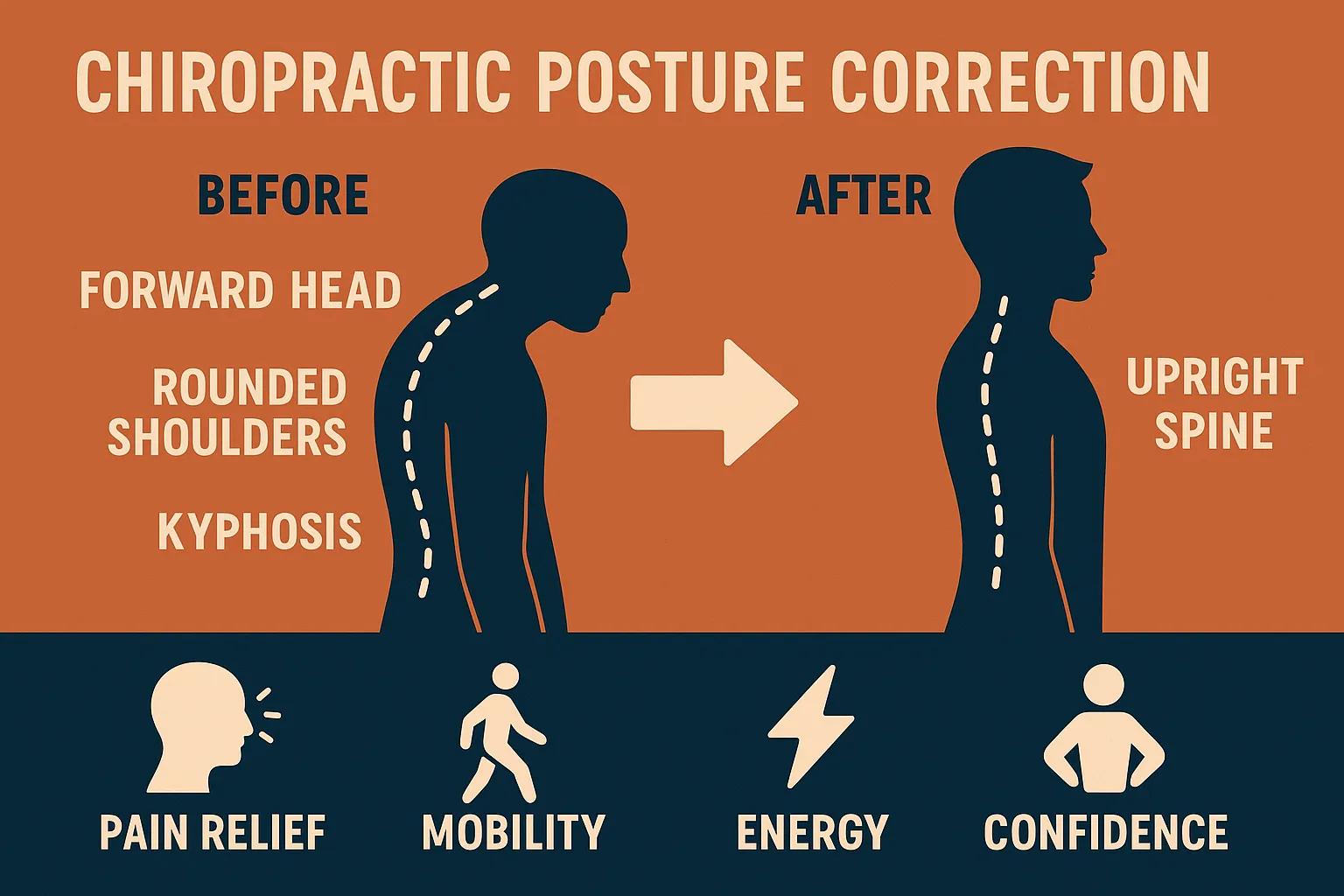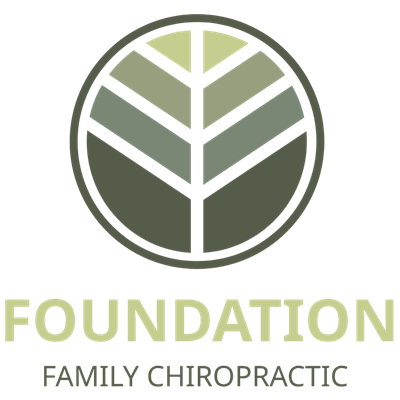Enhance Your Well-being with Chiropractic Posture Correction
Slouching isn’t just about appearance; it’s a significant contributor to persistent pain, muscle tightness, and a diminished quality of life. Chiropractic posture correction offers a gentle, natural approach to realign your spine, rebalance your soft tissues, and retrain your body’s natural posture for lasting relief. In this guide, you’ll discover the root causes of poor posture and its impact on your health, learn how chiropractic adjustments and soft tissue therapies work to realign your spine and muscles, and explore the key advantages of corrective care—from pain reduction to increased energy and self-assurance. We’ll define common postural issues like forward head posture and rounded shoulders, discuss spinal manipulation techniques and ergonomic advice, and highlight the comprehensive benefits of a stable, well-aligned spine. By understanding both the origins of postural problems and the methods for correction, you can take empowered steps toward better posture, a more efficient nervous system, and overall vitality.
What Causes Poor Posture and How Does It Affect Your Health?
Poor posture arises when your spine’s natural curves shift from their optimal alignment, creating undue stress on your vertebrae, muscles, and ligaments. This imbalance develops gradually as joints move out of their ideal positions and surrounding tissues adapt by tightening or weakening. For instance, extended periods of slouching can lead to forward head posture, straining the neck joints and potentially compressing nerve pathways.
Muscle imbalances occur when certain muscle groups become overworked while their opposing muscles become underutilized, compromising joint stability and increasing the likelihood of back pain. Ligament strain and joint irritation further reinforce these detrimental movement patterns. These mechanical factors explain why poor posture often presents as neck stiffness, mid-back tension, and lower back discomfort.
The resulting health consequences extend beyond localized aches. Restricted movement of the rib cage can limit lung capacity, leading to shallow breathing and feelings of fatigue. Altered abdominal mechanics may affect digestive processes and contribute to tension headaches. Collectively, these systemic effects underscore the critical importance of posture correction for overall health.
To better understand the core factors that contribute to postural decline, consider the following common causes.
- Extended periods of sitting at a desk without proper ergonomic support can lead to rounded shoulders and a forward head position.
- Excessive screen time encourages the neck to bend forward, overworking the cervical muscles.
- Weak core and gluteal muscles struggle to support the natural curves of the lower back during standing and movement.
- Chronic stress can trigger tension in the upper trapezius muscles, causing the shoulders to elevate and the head to tilt forward.
- An improperly set up workstation can force sustained spinal flexion and hip joint compression.
A clear comparison of how each factor influences spinal mechanics follows:
| Postural Factor | Characteristic | Effect on Spine |
|---|---|---|
| Extended Sitting | Hip and lumbar flexion | Increases strain on the lower back |
| Screen-Focused Neck Flexion | Forward head position | Increases stress on cervical joints |
| Weak Core Muscles | Insufficient abdominal stabilization | Reduces support for the lumbar spine |
| Chronic Muscle Tension | Elevated shoulders and tight trapezius | Alters shoulder blade alignment |
| Poor Workstation Ergonomics | Non-adjustable chair or desk height | Promotes spinal flexion and slouching |
These underlying causes provide a foundation for understanding specific postural patterns and how targeted chiropractic interventions can effectively correct them.
What Are the Common Types of Poor Posture?
Poor posture often manifests in predictable patterns, each placing unique stress on your musculoskeletal system. Forward head posture occurs when your head juts forward of your shoulders, significantly increasing the load on your cervical vertebrae. Rounded shoulders develop when the chest collapses inward and the upper back rounds, straining the thoracic joints. Kyphosis refers to an exaggerated curve in the mid-back, which can restrict chest expansion and hinder breathing. Swayback, or hyperlordosis, is characterized by an excessively arched lower back, placing undue stress on lumbar discs.
Identifying these distortions is the crucial first step toward effective chiropractic posture correction.
- Forward head posture can add up to 30 pounds of extra weight to your cervical spine for every inch the head moves forward.
- Rounded shoulders create an imbalance between tight chest muscles and weak muscles in the upper back.
- Thoracic kyphosis can impede the natural motion of the rib cage, disrupting optimal breathing mechanics.
- Hyperlordosis increases pressure on the front of the lumbar discs, potentially leading to premature wear and tear.
Understanding the distinct characteristics of each pattern helps guide personalized adjustments and exercise plans for lasting spinal realignment.
How Do Sedentary Lifestyles and Technology Use Contribute to Bad Posture?
Sedentary habits and prolonged engagement with digital devices can train your body into static, flexed positions, weakening the structures that support good posture. Sitting for extended periods can tighten the hip flexors and hamstrings, encouraging the lower back to round. Frequent use of smartphones or tablets often leads to neck flexion, promoting forward head posture and creating an imbalance between the deep neck flexors and extensors.
When your core stabilizers and postural muscles weaken, your spinal joints rely more heavily on passive ligaments for support, increasing the risk of misalignment and subluxation. Over time, nerve compression and muscle imbalances can solidify these poor movement patterns.
To illustrate the interplay between lifestyle habits and postural deterioration, consider the following overview table.
| Lifestyle Factor | Typical Postural Change | Muscular Impact |
|---|---|---|
| Extended Sitting | Lumbar rounding | Tight hip flexors and weak glutes |
| Smartphone “Tech Neck” | Cervical flexion | Overactive upper trapezius muscles |
| Lack of Movement Breaks | Reduced thoracic mobility | Stiffness in the mid-back |
| Screen-Centered Workstation | Rounded shoulders | Shortening of pectoral muscles |
| Infrequent Stretching | General muscular tightness | Poor spinal flexibility |

These lifestyle-induced postural distortions highlight why integrating ergonomic strategies and regular movement breaks is essential alongside chiropractic posture correction.
What Health Risks Are Associated with Poor Posture?
Chronic postural misalignment can trigger a series of health risks that extend far beyond simple back pain. Compressed nerves in the cervical spine may result in tingling or numbness in the arms and hands. Discs subjected to uneven pressure in the lumbar region can bulge or herniate, potentially causing sciatica. Restricted thoracic mobility can impair rib expansion, reducing respiratory efficiency and oxygen intake.
Poor posture can also disrupt the balance of the autonomic nervous system, potentially contributing to digestive problems, headaches, and fatigue. Over time, the wear and tear on joints from uneven loading can accelerate the development of osteoarthritis in the spine and other joints.
- Nerve compression syndromes that manifest as radiating pain or altered sensations.
- Disc issues such as bulges or herniations resulting from uneven lumbar stress.
- Impaired respiratory function due to reduced expansion of the rib cage.
- Accelerated joint degeneration and arthritis caused by chronic misalignment.
- Persistent muscle tension that leads to tension-type headaches.
Understanding these potential complications emphasizes the importance of seeking early chiropractic intervention to restore proper alignment and prevent long-term issues.
How Do Chiropractic Adjustments Correct Posture and Improve Spinal Alignment?
Chiropractic adjustments involve precise manual or instrument-assisted techniques applied to spinal joints to correct misalignments (subluxations) and restore optimal alignment. By realigning vertebrae, these adjustments reduce abnormal stress on discs, ligaments, and muscles. This mechanical correction also helps normalize nervous system function by decreasing interference at nerve roots.
During a typical session, your chiropractor will assess your spinal mobility and pinpoint areas of fixation. A targeted adjustment applied to the specific joint encourages the movement of synovial fluid, helps relax surrounding soft tissues, and resets the joint’s proprioceptors. As spinal segments return to their proper orientation, your body is better able to re-establish muscle balance and joint stability.
Soft tissue therapy and rehabilitative exercises further support this realignment by releasing restrictions in the fascia and strengthening the muscles responsible for posture. Together, these therapies provide a comprehensive strategy for posture correction that addresses both the skeletal and muscular components of the issue.
What Is a Spinal Adjustment and How Does It Realign the Vertebrae?
A spinal adjustment is a controlled force applied to a spinal joint to correct misalignment and enhance its range of motion. Chiropractors use their hands or specialized instruments to deliver a quick, low-amplitude thrust that encourages vertebral segments to return to their ideal positions.
This realignment helps reduce irritation to nerve roots by decompressing the spaces where nerves exit the spine (intervertebral foramina) and restoring proper joint mechanics. For example, correcting a rotated lumbar vertebra can alleviate pressure on the exiting nerve, helping to reduce sciatica symptoms. Each adjustment also stimulates mechanoreceptors, signaling surrounding muscles to relax, which can ease spasms and promote balanced muscle tone.
How Do Chiropractic Adjustments Reduce Pain and Muscle Imbalances?
Chiropractic adjustments alleviate pain by restoring proper joint mechanics, which in turn reduces abnormal pressure on discs and ligaments. When vertebrae are misaligned, nearby muscles often compensate by becoming overly tense, leading to strain and discomfort. Realignment helps reset the feedback loops within muscle spindles, allowing tight muscles to relax and weak muscles to become more active.
Improved joint mobility also encourages better movement patterns, helping to break the cycle of compensatory postural habits. As muscle imbalances are corrected, overall spinal support increases, leading to fewer pain episodes and preventing recurring misalignments.
What Role Does Soft Tissue Therapy Play in Posture Correction?
Soft tissue therapy, which includes techniques like myofascial release and instrument-assisted methods, targets tight muscles and connective tissues that contribute to postural distortions. By applying sustained pressure or gentle strokes, therapists can release adhesions and improve the extensibility of tissues.
This release of myofascial tension allows corrected vertebral alignments to be maintained more effectively and supports the efficient activation of muscles. For instance, releasing tightness in the pectoral fascia can help the shoulder blades retract, complementing spinal adjustments aimed at correcting rounded shoulders. Combining soft tissue work with rehabilitative exercises ensures that muscles achieve balanced length and strength, reinforcing optimal posture.
What Are the Benefits of Corrective Chiropractic Care for Posture?
Corrective chiropractic care enhances posture by realigning the spine, balancing muscle tone, and retraining postural habits through targeted exercises and ergonomic advice. This comprehensive approach delivers a multitude of health benefits, from relieving chronic pain to improving overall function and boosting self-confidence.
Balanced spinal curves reduce abnormal joint stress, leading to fewer headaches, neck aches, and lower back episodes. Restored alignment also allows the nervous system to function without interference, optimizing organ function and the body’s recovery processes. As muscle imbalances resolve, mobility and flexibility improve, supporting better performance in daily activities and athletic pursuits.
Below is a concise comparison of the primary benefits and their underlying mechanisms.
| Benefit | Underlying Mechanism | Positive Outcome |
|---|---|---|
| Pain Relief | Vertebral realignment reduces nerve pressure | Decreased back, neck, and headache pain |
| Enhanced Mobility | Improved joint range of motion | Greater flexibility and functional movement |
| Nervous System Optimization | Reduced subluxations | Better organ function and stress response |
| Increased Energy and Confidence | Balanced posture reduces fatigue | Heightened stamina and self-assurance |
| Preventive Maintenance | Strengthening of postural muscles | Long-term spinal health |
These improvements lay the groundwork for sustained well-being and encourage healthier movement patterns.
How Does Improved Posture Relieve Back, Neck, and Head Pain?
Improved posture realigns spinal segments, which helps decompress nerve roots and reduces mechanical irritation. When the head and shoulders are positioned correctly over the thorax, muscular tension in the neck and upper back decreases, alleviating tension headaches. Restoring the natural lumbar curve helps distribute load evenly across the lumbar discs, easing lower back discomfort.
Balanced spinal curves also promote more efficient breathing and diaphragmatic movement, which can reduce the overuse of compensatory neck muscles. Collectively, these changes help interrupt the pain cycle and support lasting relief without the need for medication.
How Can Better Posture Boost Confidence, Energy, and Overall Well-being?
Better posture naturally lifts the chest, opens the airway, and optimizes oxygen intake, leading to increased energy levels and mental clarity. Standing tall with aligned shoulders and head position not only feels better physically but also projects an image of confidence. Improved breathing mechanics reduce feelings of fatigue, while enhanced mobility encourages greater engagement in daily activities and exercise.
As chronic pain subsides, levels of stress hormones tend to decrease, and mood can stabilize. The combination of reduced discomfort, increased energy, and improved self-perception contributes significantly to overall well-being and motivates individuals to maintain healthy postural habits.
Achieving and maintaining proper posture is fundamental for long-term health, and chiropractic care provides a patient-centered, non-invasive method to restore alignment, alleviate pain, and enhance function. By integrating precise spinal adjustments, targeted soft tissue therapies, rehabilitative exercises, and personalized ergonomic guidance, this holistic approach addresses the root causes of postural issues rather than just the symptoms. If you’re experiencing discomfort from slouching or chronic muscle tension, consider scheduling a consultation with a chiropractic professional to develop a personalized posture-correction plan and begin your journey toward improved spinal health.


